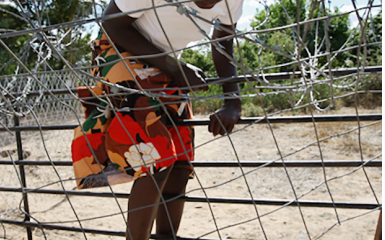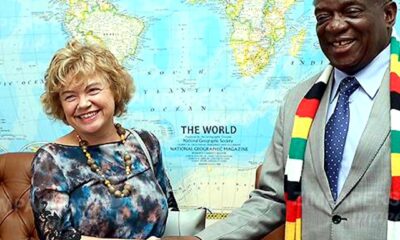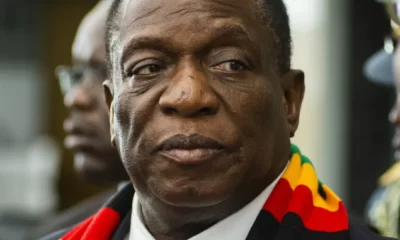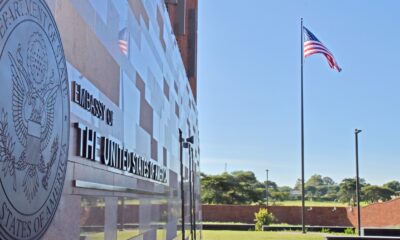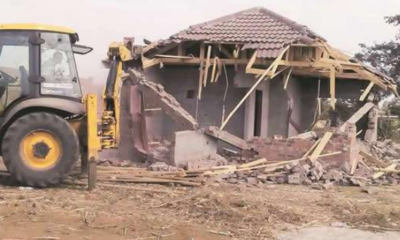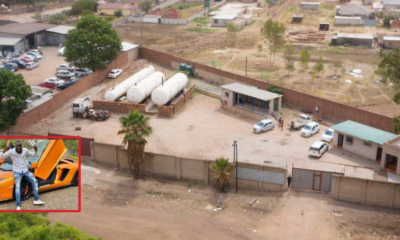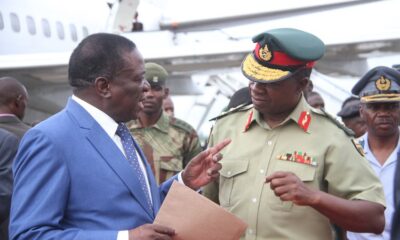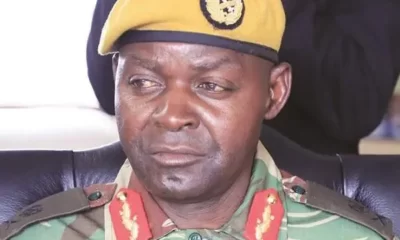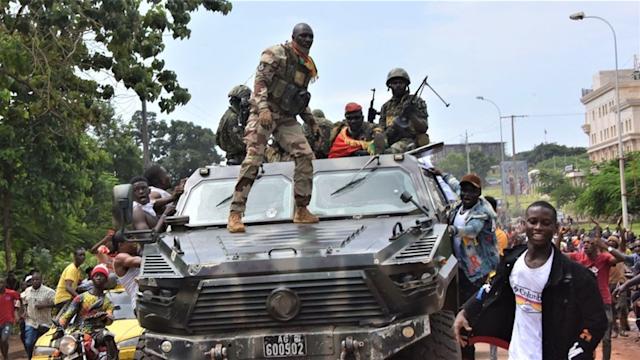
News
There have been about 475 global coup attempts since 1950: Research
Published
1 year agoon
By
NewsHawksWITH 28 coup attempts from 2008 through 2017, the previous decade saw the fewest coup attempts in any 10-year period since at least as far back as 1960.
Though coups may well be on the decline, research on coups has burgeoned since the early 2000s.
The increased scholarly interest in coups can likely be attributed to a number of factors.
First, high-profile coups like the 2011 ouster of President Hosni Mubarak in Egypt during the Arab Spring uprisings and the more recent autocratic deepening after the 2016 failed coup in Turkey highlight the importance of coups in shaping global politics.
Increased attention from the media and policymakers has been coupled with the rise in studies that examine the causes and consequences of coups.
Second, while past research largely focused on particular cases, the introduction of new datasets has allowed scholars to examine coups across time and space to reveal more generalisable patterns.
Finally, unlike topics like war, democratisation, and voting behaviour, coup researchers have only begun to tackle even the most basic research questions when it comes to coups.
The bulk of coup literature attempts to explain why coups come about. Studies focused on predicting coups often focus on factors like coup-proofing, domestic protests and instability, and how international actors can either foment or stymie coup attempts.
A smaller and growing literature considers how coups influence other processes, often focusing on outcomes like democracy, economic development, and interstate disputes.
What are coups?
Some of the earliest studies to use cross-national coup data include work from O’Kane (1987) and Londregan and Poole (1990).
These scholars pointed our attention to factors like poverty, which is strongly associated with coup attempts. As other scholars continued to build on the quantitative study of coups, variations in how coups are defined conceptually and operationalised empirically also arose.
Seeking to add coherence to the empirical scholarship on coups, Powell and Thyne (2011) brought together 15 previous studies that had used separate large-N datasets of coups in an attempt to provide a clear theoretical definition and empirical dataset of coups since 1950.
They focus on three main characteristics to define coups: targets, perpetrators, and tactics.
Focusing on the target of coups, most scholars agree that coups can only be perpetrated against the chief executive. This rule differentiates coups from other processes that are theoretically distinct from coups.
For instance, rebellions usually seek either to overthrow the entire regime and replace the government or to succeed and form a new state (Gleditsch, Wallensteen, Sollenberg, & Strand, 2002).
On the other side of the spectrum, mutinies often seek to redress grievances over things like pay but do not attempt to oust leaders (Dwyer, 2017). Though rebellions, mutinies, and other anti-regime activities like protests are often correlated with coups, isolating the target to chief executives allows scholars to study coups as the distinct processes that they are.
Next, some disagreement among scholars emerges regarding perpetrators of coups. The typical coup is perpetrated by a high-ranking officer of the military, but we have also seen chief executives ousted by rebels, civilian elites, and seemingly random assassins.
Given that assassinations and civil conflicts are distinct processes, most scholars agree that coups can only be perpetrated by elites within the state apparatus. This qualification omits large-scale events like rebellions and major protests, and also captures the conspiratorial nature of coups by omitting lone-wolf attempts to end an executive’s life, including efforts by members of the armed forces.
The insider nature of these events is particularly distinctive, as incentives to oust a leader from those within a regime likely depart from those of politically excluded or discriminated populations that undertake rebellion.
Third, the tactics that must be used in a coup attempt are likely where we see the largest area of disagreement among how scholars, politicians, and the media define coups. Most scholars agree that a coup must be illegal and overt, which seems rather straightforward.
However, three main factors lead to ambiguity.
First, politicians often have an incentive to describe challenges to their rule as a coup even if they are perfectly legal, and the media often sensationalises challenges using the same term.
For example, Brazilian president Dilma Rousseff and her supporters repeatedly referred to her impeachment proceedings using the word “coup” in spite of its legality (Watson, 2017).
Second, external actors often have an incentive to avoid using the term “coup” even when it meets all reasonable characterisations of a coup.
We saw a recent case of this with the African Union’s refusal to characterise the 2017 ouster of (the late former) Zimbabwean President Robert Mugabe as a coup, for example (Roessler, 2017).
Third, some scholars disagree as to whether we must see overt tactics like tanks in the street to capture a coup attempt or whether plots and rumours also count. Given that executives often have an incentive to justify purges and repression through what Kebschull (1994, p. 568) has referred to as “deliberately contrived nonsense,” most scholars agree that overt action must be taken for an event to count as a coup.
Finally, there is some ambiguity in the proper conceptualisation of a failed versus successful coup.
After ousting the executive and seizing power, most scholars are comfortable with using a threshold of maintaining control for at least one week to define a coup as successful (for example, McGowan, 2003; Thompson, 1973).
However, all recognise that the one-week threshold is clearly arbitrary. Thyne, Powell, Hayden, and VanMeter (2018) recently attempted to rectify this by coding the duration that coup leaders — or their appointed allies — maintain power following a coup, which allows success to be measured on a continuum.
Others have characterised coup outcomes by considering whether or not the putsch altered the regime.
For example, Aksoy, Carter, and Wright (2015) differentiate between “successful regime change coups” and “successful reshuffling coups” by considering whether (the former) or not (the latter) the incoming coup leader replaces the regime or simply replaces the rule, in what Geddes has described as the effective equivalent of an authoritarian vote of no confidence (Geddes, 2010, p.66).
Taken together, many scholars studying coups today use the Powell and Thyne (2011, p.252) dataset to conceptualise coups with the following definition.
Powell and Thyne conceptually define coups as “illegal and overt attempts by the military or other elites within the state apparatus to unseat the sitting executive.”
They operationally define a successful coup as one in which “the perpetrators seize and hold power for at least seven days.” This definition has been adopted by many scholars, including, inter alia, studies on pro-government mobilisation in authoritarian regimes (Hellmeier & Weidmann, in press), military schools (Bohmelt, Escribá-Folch, & Pilster, 2019), and civil war duration (Wiegand & Keels, 2019).
Moving to empirical measures, the Powell/Thyne dataset records 475 coup attempts since 1950. Roughly half of coups (49.7%) have been successful during this time period. Trends across time and space are also noteworthy. It is clear that the frequency of coups has been on the decline since the late 1960s.
This is largely keeping with trends in other conflict processes of interest like interstate wars and civil conflicts (Gates, Nygård, Strand, & Urdal, 2016). However, while coup attempts are on the decline, it is notable that coups over the last decade or so have a far higher success rate than in previous periods. Regarding spatial dispersion, few regions have been immune to coups since 1950. Africa (37% of total) and Latin America (30%) have seen the highest frequency, followed by the Middle East (16%), Asia (13%), and Europe (2%). Considering both spatial and temporal trends, Latin America led the charge with coup activity until around 1970, and then Africa has largely led since.
These trends are generally consistent with regions studied by coup scholars. The earliest work on coups primarily focused on Latin America, which was a hotbed of coup activity particularly during the 1950s and 1960s (for example, Fossum, 1967). More recent work often focuses on coup activity in Africa, which has seen the highest rate in coups since the turn of the century (e.g., Powell, Lasley, & Schiel, 2016).
The causes of coups
As one might expect, the bulk of the literature on coups focuses on why they come about. Scholars have considered a variety of factors in this vein. Some focus on individual attributes of leaders, while others broaden the scope to state institutions, mass politics, and even international factors. The subsequent sections summarise this rather broad area of work into four main categories.
Civil-military relations and coups
To begin, a substantial body of work considers the relationship between the executive and the military to understand coups.
The primary emphasis here is on decisions made by leaders to deter coup activity.
Known as the guardianship dilemma, the basic problem for leaders is that armed forces must be strong enough to challenge threats to the regime from external actors and mass uprisings; however, the same tools used to deter threats external to the regime can be used against the regime itself in the form of a coup (Feaver, 1999; Huntington, 1957; McMahon & Slantchev, 2015; Svolik, 2012).
Understanding the strategies that leaders use to solve the guardianship dilemma has produced two related sets of literatures.
First, scholars have considered how the threat environment drives executive decisions about military strength.
For example, Svolik (2012) argues that executives will empower the military when threats from the population are extreme, and can avoid coups when threats are meager by weakening the military.
As shown by McMahon and Slantchev (2015), however, devising the perfect balance to deter threats and assure military loyalty is easier said than done. If both the military and the executive perceive a strong internal threat, then coups are uncommon because both actors have a strong incentive to hold the regime together.
When views about the threat environment diverge, however, militaries may be likely to coup. Moving beyond military empowerment, scholars have considered how elites are more generally appeased by executives.
For instance, Bove and Rivera (2015) show that co-opting elites through elected authoritarian legislatures helps executives avoid coups, while Makara (2013) considers how leaders like Egypt’s Mubarak provided post-retirement appointments and financial awards to military elites to assure loyalty.
The second main area of work focused on the guardianship dilemma considers coup-proofing. At the most basic level, coup-proofing includes moves by the executive to minimise the likelihood that a small group can seize power (Quinlivan, 1999).
This includes a variety of tactics, including appointing and promoting military officers based on loyalty rather than merit, purging potentially disloyal officers, creating parallel and rival military structures, rotating military officers, and centralizing control of information (Albrecht, 2015; Belkin & Schofer, 2003; de Bruin, 2018; Pilster & Böhmelt, 2012; Pollack, 2002; Powell, 2012; Sudduth, 2017a).
While early work from scholars like Quinlivan (1999) provided thorough descriptions of how leaders in places like the Middle East coup-proofed their regimes to maintain power for decades, more recent work explains when we should expect executives to pursue various coup-proofing tactics and the consequences that such actions might have.
Strategies are varied, with some emphasising the ability to effectively purchase loyalty with higher military expenditures (Collier & Hoeffler, 2007; Leon, 2014). Others have pointed to why might be called structural coup-proofing, which includes building up armed counterweights to the armed forces (Bohmelt & Pilster, 2015; de Bruin, 2018; Powell, 2012).
Following qualitative efforts that have illustrated the importance of utilising ethnic identity in the armed forces (for example, Enloe, 1980; Horowitz, 2000), recent work has sought to more formally account for the manipulation of the military on ethnic lines (Roessler, 2011, 2017).
For example, Pilster and Böhmelt (2012) show that democracies engage in less coup-proofing than non-democracies, while Sudduth (2017b) shows that executives are apt to purge potential rivals immediately following coups. The efficacy of these efforts, however, is unclear.
While it is generally presumed that leaders are effective in preventing coups, the empirical record demonstrates a variety of contradictions.
For example, quantitative efforts to investigate “counterbalancing” noted in the previous two paragraphs have pointed to a reduction in coup activity, a non-robust effect, a curvilinear effect, and no effect (for example, Albrecht, 2015).
Further, even if promoting a coup-inhibiting trend, these same practices have also been linked to an increased likelihood of rebellion against the government (Powell, 2014b, 2019; Roessler, 2011). Future studies could follow the lead of de Bruin (2018) in providing more attention to how well data quality and operationalization allow us to make accurate inferences.
Protests, conflict, and coups
A second main area of work seeking to understand why coups come about looks beyond civil-military relations by considering how the broader population influences elite decisions to coup. Coup scholars have long recognised that militaries are apt to intervene when the public demonstrates against the regime (Finer, 1962; Sutter, 1999; Welch, 1970), and the correlation between protests and coups is one of the most consistent relationships shown in the empirical literature on coups.
More recent work has attempted to explain the causal mechanisms that link protests and coups, and to further describe when we should expect protests to result in coups.
For example, Casper and Tyson (2014) show that protests can ease coordination problems among coup plotters, especially when a free media is allowed to provide information about public discontent. Lee (2015) considered the type of regime, explaining that protests under personalist regimes are apt to result in coups, while non-personalist forms of authoritarian rule are apt to result in repression of the protesters.
Meanwhile, Johnson and Thyne (2018) show that protests near the capital city are apt to spur coups, while dispersed protests have little effect.
Moving beyond protests, a nascent body of work considers the nexus between higher forms of anti-regime activity, civil conflicts, and coup activity.
For example, Bell and Sudduth (2017) show that civil wars are apt to spur coups, especially when governments face strong rebels, and Thyne (2017) demonstrates that coups during civil wars make war termination more likely.
Additional dynamics — addressed in the subsequent sections — can be seen with international conflict. However, empirical scholarship is still in its infancy when attempting to explain when soldiers turn their arms away from the enemies of the state and toward the state itself.
Coups and the economy
Similar to other processes like civil conflicts, scholars have consistently demonstrated a strong link between economic weakness and coups. Londregan and Poole (1990) were among the first to assess this link in a large-N context, and more recent evidence buttresses this relationship. Scholars have more recently attempted to refine the mechanisms linking economic factors and coups.
For example, Houle (2016) considers class inequality, which is apt to incentivize people to challenge the government but also decreases the opportunity to do so with stronger militaries. The end result is fewer civil conflicts, but an increased likelihood of coups. An important study by Kim (2016) considers the dynamic nature of the economy.
Differentiating between permanent and transitory shocks, Kim instruments economic shocks using rainfall and temperature variation to ease endogeneity concerns, finding that shocks indeed increase the likelihood of coups. These shocks, however, appear to be most meaningful in smaller economies.
Meanwhile, Tusalem (2010) demonstrates that developing states can lower the likelihood of coups by securing property rights to ease elite concerns about expropriation of wealth, while Powell and Chacha (2016) borrow from the capitalist peace literature to argue that a range of economic dynamics can incentivise domestic and international actors to actively avoid the potentially destabilising consequences of a coup.
A considerable amount of scholarship has investigated the association between commodity-driven economies and political instability more generally.
Dubbed “the resource curse,” economies dependent on natural resources have been said to suffer from problems including economic stagnation and increased likelihood of civil war (for example, Ross, 2012).
And while notorious cases such as Nigeria point to the importance of resource wealth in the coup story, empirical scholarship on the association with coups is limited, and what exists seems contradictory.
For example, explorations by Cotet and Tsui (2013), Escribà-Folch and Wright (2010), and Singh (2014) indicate that oil wealth has no association with coups, while Collier and Hoeffler (2007) report the same for natural resource rents more generally.
Studies including Powell and Chacha (2016) find that higher levels of oil wealth are associated with significantly higher coup risk. These studies are at least in partial contrast to a previously demonstration association between oil wealth and the stability of authoritarian regimes (for example, Smith, 2004), suggesting the need for more theoretical and empirical consideration.
Institutions, politics, and coups
As political scientists largely drive the research on coups, it should come as no surprise that plenty of scholars have sought to understand how things like elections, democratisation, and institutions influence the likelihood of coups.
Early research in this vein from Belkin and Schofer (2003) showed that the strength of civil society, regime legitimacy, and past coups are strong predictors of coups.
These sorts of factors, particularly the exclusion of a large proportion of the population from political institutions, have been found to increase the likelihood of coups alongside civil wars and riots (Bodea, Elbadawi, & Houle, 2017). Beyond this basic level, scholars have sought to understand how variations in democracy and authoritarianism influence coups.
First, scholars have sought to understand the relationship between coups and democracy. While it is easy to assume democracies are less coup-prone, the literature has arrived at varied results. Bell (2016) explains that democracy makes it difficult for executives to repress threats from rivals, which makes coups easier to plot.
However, rivals have less incentive to coup in democracies because they can address their grievances and achieve power via more legitimate processes. Bell finds evidence that democracies are less coup-prone, but coups plotted against democracies are more likely to succeed.
Hiroi and Omori (2013) show an inverted-U relationship, with coups most likely to happen in semi-authoritarian regimes, mirroring the theoretical exploration of authoritarian consolidation by Svolik (2009). Taking a more dynamic approach and focusing on Africa, Lindberg and Clark (2008) seem to align most closely with Bell (2016) in demonstrating that liberalising regimes are less likely to face coups.
More recently, Powell, Faulkner, Dean, and Romano (2018) argue that these discrepancies can be attributed to conditional effects, finding that democracies are significantly more coup-prone than civil autocracies when the regime is young and when military expenditures are low but become significantly more resistant to coups once reaching the median level of these factors.
Second, given that most coups happen within authoritarian regimes, plenty of scholars have attempted to understand how variations in authoritarianism influence coups and other forms of leader removal.
For example, Gandhi and Przeworski (2007) explain that authoritarian institutions lengthen a dictator’s tenure in office. While this finding led to the common argument that elections stabilise autocracies, Wig and Rød (2016) add important nuance to this argument.
Considering elections in authoritarian regimes, they explain that election outcomes can reveal information about the strength of the opposition and the likelihood of a successful revolution.
If this information reveals that a successful revolution is likely, coups are apt to come about as a way for elites to maintain their privileged status (see also Acemoglu & Robinson, 2001).
— OXFORD RESEARCH INTERNATIONAL STUDIES.
… To be continued
You may like

